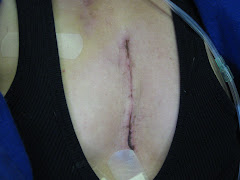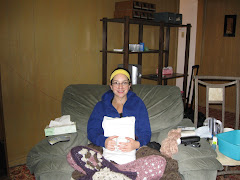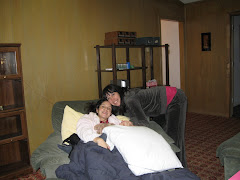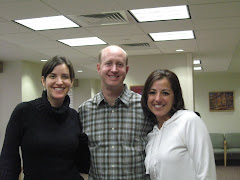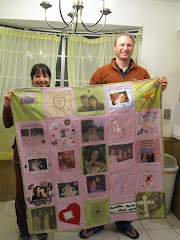Hello everyone. Thought we'd share an update....
Jennifer's exercise levels are low compared to pre-surgery levels. More oxygen is required for rest and activity, 3-6 liters versus 1-3 liters.
Flolan (intravenous medication) remains unchanged. Getting outside at least once we day, we’re able to stave off cabin fever. We are now a great source for obscure movie reviews.
With surgery 12 days ago, Jenn's recovery rate is being monitored closely. On Wednesday the 25th we met the specialty clinic team for a scheduled appointment.
She is believed to have pleural effusion, which is excess fluid that accumulates in the pleural cavity, the fluid-filled space that surrounds the lungs.
The fluid is a combination of serum, pus and or blood. The surgeon, Dr. Ring, speculates blood resulting from surgery, which would also explain the fluid’s immobility throughout the cavity.

An excessive amount of such fluid impairs breathing by limiting the expansion of the lungs during inhalation. From x-rays, 500-1,000 ml is estimated in the right lung with less in the left lung.
There are 2 options:

If the fluid becomes hardened, it can be difficult for the body to absorb it, and or for it to be removed through use of a syringe.
Jennifer's INR level, a measurement of blood thickness, is 3.5. In order to operate, we must thicken the blood by stopping use of Coumadin and increasing intake of vitamin K.
Coumadin is a blood thinner and a medication in Jennifer's routine to limit the risk of blood clots.
In the meantime, Jennifer is doubling her Lasix. Lasix is an oral medication to aid the body in removing fluid, and also a part of Jennifer's normal routine.
Jennifer is also increasing potassium levels, to contradict the extra fluid loss from doubling Lasix. She is eating more regularly, up throughout most of the day, and still smiling.
Our next appointments are on Monday to check INR levels, evaluate fluid levels, and make decisions.
Jennifer and her Mother, Celina were planning to depart by plane to Albuquerque on Wednesday.
Her father, George, will drive the vehicle back starting Tuesday, after dropping me off at DFW for a trip to Chicago.
If option 1 is chosen, travel plans should be uninterrupted. If option 2 is chosen, there will be a re-evaluation as a hospital stay is accommodated.
There are 2 WINS we're marking in the books. First, Jennifer's x-ray films have shown improvement in fluid levels from Monday's exam. That's before doubling of the Lasix.
Second, Jennifer's incentive spirometer results have increased from a high water mark of 1,000 milliliters to over 1,500 milliliters. Left lung inflation has improved.
I must admit, I did not anticipate this additional challenge. It’s a good reminder of what Yogi Berra told us long ago, "It ain't over 'til it's over."
I continue to admire how Jennifer takes in this experience, including its challenges. It was tough information to take, even as it helped us understand current health difficulties.
But Jennifer is strong and will overcome. We're learning how deep love can run.
Jennifer's exercise levels are low compared to pre-surgery levels. More oxygen is required for rest and activity, 3-6 liters versus 1-3 liters.
Flolan (intravenous medication) remains unchanged. Getting outside at least once we day, we’re able to stave off cabin fever. We are now a great source for obscure movie reviews.
With surgery 12 days ago, Jenn's recovery rate is being monitored closely. On Wednesday the 25th we met the specialty clinic team for a scheduled appointment.
She is believed to have pleural effusion, which is excess fluid that accumulates in the pleural cavity, the fluid-filled space that surrounds the lungs.
The fluid is a combination of serum, pus and or blood. The surgeon, Dr. Ring, speculates blood resulting from surgery, which would also explain the fluid’s immobility throughout the cavity.

An excessive amount of such fluid impairs breathing by limiting the expansion of the lungs during inhalation. From x-rays, 500-1,000 ml is estimated in the right lung with less in the left lung.
There are 2 options:
- Often done as outpatient care, Thoracentesis is an invasive procedure to remove fluid. A cannula, or hollow needle, is introduced into the thorax to draw the unwanted pleural fluid out.
- Surgery, which also requires a mechanical "scraping" to remove. Surgery would require a hospital stay plus another incision.

If the fluid becomes hardened, it can be difficult for the body to absorb it, and or for it to be removed through use of a syringe.
Jennifer's INR level, a measurement of blood thickness, is 3.5. In order to operate, we must thicken the blood by stopping use of Coumadin and increasing intake of vitamin K.
Coumadin is a blood thinner and a medication in Jennifer's routine to limit the risk of blood clots.
In the meantime, Jennifer is doubling her Lasix. Lasix is an oral medication to aid the body in removing fluid, and also a part of Jennifer's normal routine.
Jennifer is also increasing potassium levels, to contradict the extra fluid loss from doubling Lasix. She is eating more regularly, up throughout most of the day, and still smiling.
Our next appointments are on Monday to check INR levels, evaluate fluid levels, and make decisions.
Jennifer and her Mother, Celina were planning to depart by plane to Albuquerque on Wednesday.
Her father, George, will drive the vehicle back starting Tuesday, after dropping me off at DFW for a trip to Chicago.
If option 1 is chosen, travel plans should be uninterrupted. If option 2 is chosen, there will be a re-evaluation as a hospital stay is accommodated.
There are 2 WINS we're marking in the books. First, Jennifer's x-ray films have shown improvement in fluid levels from Monday's exam. That's before doubling of the Lasix.
Second, Jennifer's incentive spirometer results have increased from a high water mark of 1,000 milliliters to over 1,500 milliliters. Left lung inflation has improved.
I must admit, I did not anticipate this additional challenge. It’s a good reminder of what Yogi Berra told us long ago, "It ain't over 'til it's over."
I continue to admire how Jennifer takes in this experience, including its challenges. It was tough information to take, even as it helped us understand current health difficulties.
But Jennifer is strong and will overcome. We're learning how deep love can run.






